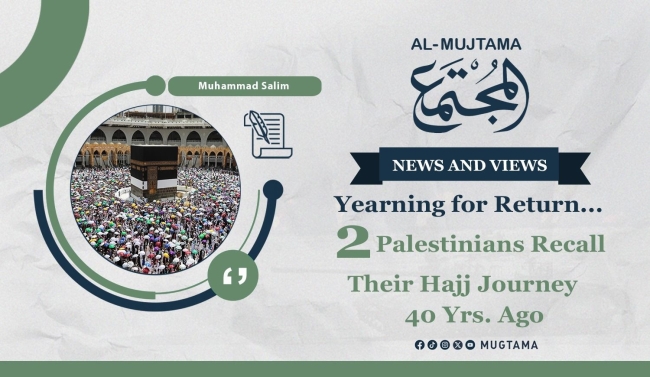Yearning for Return... 2 Palestinians Recall Their Hajj Journey 40 Yrs. Ago
Hajjah Kafaya Al-Hamidi (90 years old) is trying to gather memories of her pilgrimage to the Sacred House of Allah, a journey she embarked on 40 years ago, which was filled with both joy and danger at the same time, especially considering that travel conditions, accommodations, and crossings were different from what they are today.
Hajjah Al-Hamidi, from the Maghazi refugee camp in the heart of the Gaza Strip, tells "Al-Mujtama": "In 1978, I registered for Hajj with my brother. I was longing for the ancient house of Allah, and I sold some of my jewellery for this trip. At that time, the cost of Hajj was 100 Jordanian dinars, but today the cost of Hajj is more than 4,000 Jordanian dinars, which is multiple times what it was in our time."
She adds: "A month before heading for the Hajj journey, I went to the blessed Al-Aqsa Mosque and prayed there. Likewise, I went to it after my return from Hajj."
Farewell Rituals of the Pilgrims
Hajjah Al-Hamidi recounts how ululations mixed with tears of farewell emanated from the homes of the pilgrims before their departure to Mecca. Every beloved one and neighbour visited her to bid her farewell amidst the ululations and chants, known as "Tahneen," as the pilgrims then set off in caravans from Gaza to the crossing with Jordan, because all Palestinian pilgrims at that time, as she describes it, travelled in land caravans.
Al-Hamidi points out that the vehicles carrying them were extremely hot, with no air conditioning, and the journey from Gaza to Jordan and then to the Kingdom of Saudi Arabia lasted for 5 consecutive days.
She describes the days of staying in Mecca, Mina, and Arafat, and her survival from the severe crowding in the Jamarat area in Mina. She confirms that the memories of Hajj are still recounted by her to her grandchildren, as it was a spiritual journey.
She recalls a tragic incident that occurred during her return and with the pilgrims accompanying her, which was the death of her lifelong friend and companion in the Hajj journey at the Jordanian-Saudi border. "May Allah have mercy on her; she passed away after the Hajj journey, it was a painful day."
The Journey of Life
On his part, Hajj Ayed Al-Tarabeen (85 years old) from Gaza, told "Al-Mujtama": "I went on the Hajj journey in 1984. I was young then and registered for Hajj. There were no Hajj lotteries like today, no flights. The journey to Hajj was a road trip, and our journey took 37 days, including Hajj and the travel back and forth."
Al-Tarabeen pointed out a custom he disliked, which was that they treated those going on Hajj as if they might not survive, due to the difficult road and the hot weather conditions in the holy lands, and the intense crowding in Mecca before the major expansions took place later in the Grand Mosque and the Jamarat area.
He noted that Palestinian pilgrims insisted on visiting the blessed Al-Aqsa Mosque before or after their return from Hajj, in what is known as "the sanctification of Hajj."
Regarding the rituals of reception and safe return from the Hajj journey, Hajj Al-Tarabeen explained that he hosted a huge lunch feast, where a calf was slaughtered in celebration and sacrifice for Allah Almighty for the blessing of completing Hajj and returning safely. This was accompanied by the distribution of gifts and Zamzam water to the well-wishers.
-------------------------------------------------------------


